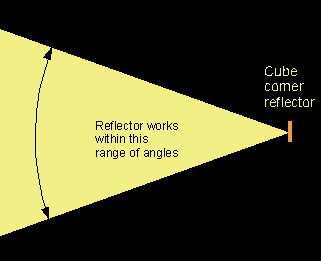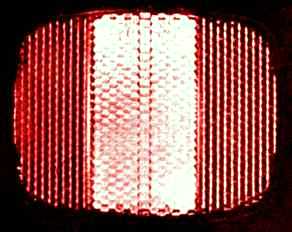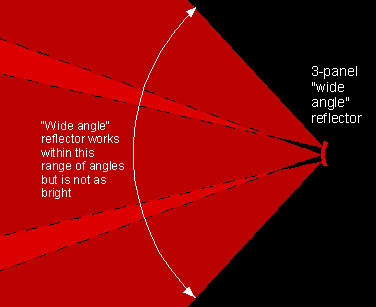Some reflectors are brighter than others, or work best under different conditions.
Here are the main issues:White is brighter than amber, amber is brighter than red.The relative brightness of white, amber and red reflectors is approximately 100%, 62% and 25%. Red is the standard color to identify the rear of a vehicle, and white is the standard color to identify the front (but this means you should have a white headlight, since front-facing reflectors usually don't work). Amber is understood as a warning, and is commonly used for marker lights and turn signals.
A white reflector at the rear could confuse motorists behind you into thinking you are riding toward them on the wrong side of the road. There is rarely any objection to an amber rear reflector; even less so if you also use a red taillight and/or additional, red reflector to meet the legal requirement. Cube-corner reflectors work over a limited range of angles.
The reflective surfaces of a cube-corner reflector do not have a mirror coating. Instead, they use the principle of total internal reflection -- the same principle by which gemstones reflect light internally. Total internal reflection works only within a limited range of angles, which can be as little as ±20 degrees. Light that strikes the reflector from larger angles goes through the reflector instead of being reflected back. This limitation is why you must aim your reflectors. Quick knowledge check: What's wrong with
this picture? Kiddie Kart hits a (foul) home run for nighttime safety! Cube-corner reflective tape such as Reflexite™ works over a limited range of angles. In practice, this means that the tape is effective when (for example) wrapped around your legs, but may not be very effective (for example) on the back of a helmet if you ride in a low racing position -- you might also mount the reflective tape under the rim of the helmet. Glass bead "cat's eye" reflective materials generally retain their reflective properties to some degree in any direction from which their surface is visible, though foreshortening reduces their effective area. The all-directions reflector set mandated by the U. S. Federal Government misleads people into riding without lights.The photo below is of a three-panel "wide-angle" cube corner rear reflector as specified by the United States Consumer Products Safety Commission (CPSC) for installation on new bicycles. As you can see, only the middle one of the three panels reflects directly to the rear.
The area of the "wide angle" reflector that is effective directly to the rear is only about 1½ square inches. The two side panels work in directions diagonally to the rear, as shown in the next illustration.
The "wide angle" properties extend the reach of the reflector only horizontally, not vertically. You must still aim a "wide-angle" reflector. If it is tilted up or down (like the ones in the trailer photo above), it doesn't work. All of the area of a 3-inch wide, amber reflector you can buy at an auto parts store reflects directly toward the rear. It has about 10 times the brightness directly to the rear -- where cars actually come from -- compared with the "wide-angle" bicycle reflector. In addition to the three-panel rear reflector, the CPSC also requires a three-panel front reflector and wheel reflectors. These are supposed to make you visible from every direction. But as we've seen on the previous page, reflectors are only reliably effective for drivers behind you. Drivers in other directions usually don't have their headlights aimed at you, and pedestrians don't have headlights at all, so you always need your own headlight. If the road curves sharply so a driver is diagonally behind you, that driver will probably be going slowly enough that the conventional reflector provides sufficient warning time, but it is a good idea to use a bright taillight too -- and in some states, one is required by law. Many people get fooled into thinking they don't need lights because new bikes are equipped with reflectors facing in every direction. In case you are curious how the U.S. Government came up with its deeply flawed system of nighttime protection for bicyclists, John Forester has provided a blow-by-blow description on his Web site. To make a long story short, the motivation was to say something was being done about nighttime safety, without requiring manufacturers to provide headlights. The Consumer Product Safety Commission bicycle regulations were developed in the mid-1970s. To this date, the CPSC has not established any standard for bicycle lights. There is an international standard, but it has no force of law in the United States. In the United States, the best bicycle lights are sold side by side with others that don't meet a reasonable standard. Reflectors can be designed for best performance at shorter or longer distances.If the cone of light which a reflector sends back is narrow, that reflector appears very bright, but only if the driver's eyes are at nearly the same angle as the headlights. If the cone of light is wider, the reflector is visible at a greater angle away from the headlights, but is not as bright. Generally, reflectors made of glass bead material have a relatively wide pattern. Cube corner reflectors can be designed to have a wide or narrow pattern. The lesser brightness with a wide pattern can be compensated by using a larger reflective area. Then the reflector can be bright, while it is still visible over a wider range of angles. No such compensation is possible to make a reflector with a narrower pattern work well as a vehicle approaches and the angle between its headlights and the driver's eyes increases. The reflectors currently specified by the CPSC are small and have a narrow beam pattern. Usefulness and limitations of pedal reflectorsIt is often said that pedal reflectors are especially effective because their motion attracts attention. But they can only attract attention once they have been seen. Pedal reflectors are amber or sometimes white in color, but they are small -- there isn't room to make them bigger. A large, amber rear reflector is generally visible before the pedal reflectors. Pedal reflectors at the front of the pedals are rarely illuminated well enough to serve any useful purpose. Only reflectors at the rear of the pedals are effective. Even these are sometimes hidden if the bicyclist is wearing shoes with heels -- and especially if the bicyclist is pedaling on the arches of the feet, as many novices do. Pedal reflectors at the rear of the pedals have a very useful communicative role: they let a driver know that the bicyclist has stopped pedaling. In this way, they serve as the bicyclist's brake lights. They also establish a "signature" for the bicyclist -- once they are visible. The Consumer Product Safety Commission requires pedal reflectors front and rear on new bicycles. The laws of some states also require pedal reflectors -- but many pedals have no place to mount reflectors. The role of pedal reflectors can also be served by reflective ankle bands, which can be larger, and so, brighter. These do not conform to the word of the law, but they do vonform to the spirit of the law. Reflectors on gloves? Good idea!A reflective patch on the back of each glove lets you make an effective blinking turn signal for drivers behind you by sticking your arm out and rotating your wrist back and forth. For right turns, this only works if you make your right turn signal with your right hand, rather than to use the the "left-handed Boy Scout salute" turn signal that motorists have to use because their right arms are too short to reach out the passenger side window. Reflective wristbands or sleeves also may be used as turn signals, though they can't be made to blink. Next: reflectors to avoid. |




